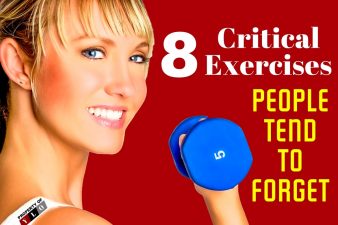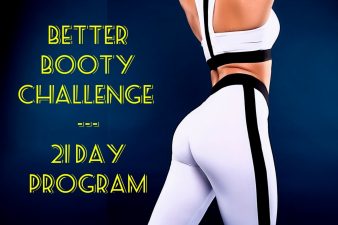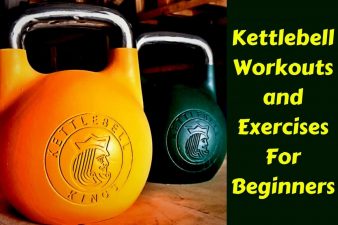Travel WOD is “Workout Of the Day” aimed at physical activities of travel. Motivation: WeightLifting: getting your luggage into an overhead compartment. Stair-Stepping: getting up to the 3rd floor in a hostel. Running/Jogging: your flight leaves in 5 minutes and you are on the other side of the airport.
Why Travel WOD Will Work For You
It is a set of workout exercises designed to be performed in order to strengthen the muscles and condition the cardiovascular. It is possible when you are traveling to still keep your fitness level up. It is also doable if you would like to get some new fitness moves into your schedule to help out with the physical activities involved with travel. Travel WOD or travel workouts will definitely work for you because it combines high and low-intensity workouts that are good for joint mobility and body flexibility. This helps to prevent stiffness and reduce the risk of injuries. It is a workout that conditions the cardiovascular and burns calories and unlike other daily workout programs, you will never get bored doing it. It’s a fun routine with different workouts for each day. Because you put a Travel WOD in your schedule, your sightseeing jaunts, your nature hikes, and any other physical activity is more enjoyable and less taxing.
Customizing your travel WOD allows you to work on all aspects of your fitness e.g. endurance, strength, flexibility etc. A customized WOD for Women should be able to provide a scaled workout program that includes squats, pushups, burpees, sprints, sit-ups, lunges, weightlifting etc. Even travelers over 50 can design their own travel workout. Something as easy as “Chair Yoga” can be used to enhance flexibility to eliminate potential soreness.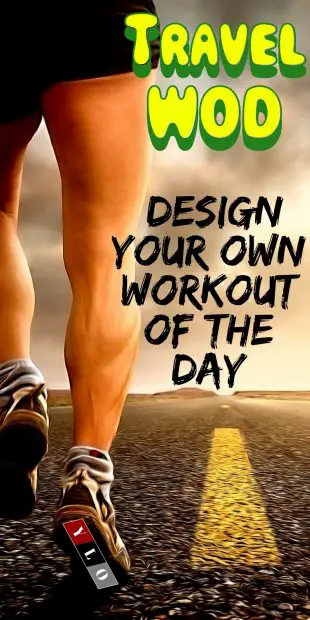
Travel WOD Actually Enhance Your Travel Experiences
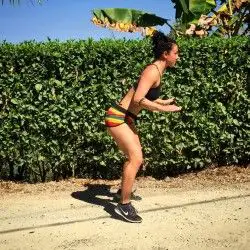 There is nothing worse than missing out on “The Best View Ever!” because you couldn’t make it to the top of the hill overlooking the city. You don’t want to be the person who stays at street level and misses out while everyone else climbs the clocktower, or the Eiffel tower or gets up to the top of an old fort. Then, for the next few days, they can only talk about the absolutely incredible scenery they saw or the breathtaking sunset/sunrise.
There is nothing worse than missing out on “The Best View Ever!” because you couldn’t make it to the top of the hill overlooking the city. You don’t want to be the person who stays at street level and misses out while everyone else climbs the clocktower, or the Eiffel tower or gets up to the top of an old fort. Then, for the next few days, they can only talk about the absolutely incredible scenery they saw or the breathtaking sunset/sunrise.
Most Travel workouts usually fall under cardiovascular training e.g. jogging, walking, cycling or swimming and resistance training e.g. Rubber exercises, dumbbells, pull-ups etc.
Simply ensure that you focus on your cardio & calisthenics. Work on your legs, hips, thighs, and waist using weights, squats, lunges etc. By working out these areas, you will end up looking great, healthy & have more energy for your travel activities. Your hips and calves will be more defined and your legs & thighs more toned.
Exercise & Fitness Free Report From Harvard Health
Travel WOD If You Have Access To A Gym
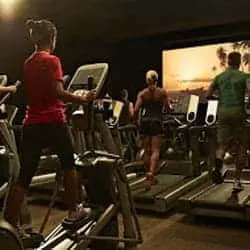
Chest Muscle Group to Concentrate On
The chest muscle group that you should work out on is the pectoral muscles. Pectoralis muscle group is composed of the pectoralis major and minor muscles.
The pectoralis major which is the larger of the two is found along the breastbone, collarbone, ribs and ends at the humerus. The reason why it is called major’ is because it’s the only muscle that forms the majority of the chest muscles. The function of the pectoralis major is to medially rotate and adduct the humerus aiding in arm movements. It also inferiorly and interiorly draw the scapula.
The pectoralis minor which is the smaller of the two is found below the pectoralis major. It originates at the front of the ribs and ends at the frontal part of the shoulder blade. It helps to move the shoulders forward and pull them down.
Best Exercise for this Chest Group Muscles
The pectoralis major and minor can be worked out by doing:
• Push-ups
• Dumbbell incline bench press
• Cable crossover
• Barbell bench press.
• Dumbbell pullover.
Back Muscle Groups to Concentrate On
The major back muscle groups are responsible for all the pulling movements such as drawing a cup towards you, pulling a tray from the shelf etc. Some of the muscles are important in stabilizing the spinal cord. To get the most out of your travel WOD, you should know the types of the back muscles, their functions and where they are located in order to understand their mechanics and know which workouts are best for them. The major back muscles groups that you should concentrate on during workouts are:
• Teres Major & Latissimus Dorsi
Teres Major is a thick flattened muscle that is found at the back just behind the upper arm. It is one of the seven scapulohumeral muscles which are attached to the humerus & the scapula. Teres Major assists the latissimus dorsi with its functions in addition to shoulder adduction & extension. It also helps to stabilize the humeral head found in the glenoid cavity.
The latissimus dorsi is a very broad flat muscle that is found at the back of the upper arm. It is this muscle which usually gives the back the V-shape that is associated with a physically fit back. They are essential in providing resistance during activities such as rope climbing, pull-ups, and rowing, facilitating internal rotation of the shoulder joint as well as lateral flexion and extension of the lumbar spine.
• Rotator Cuff
It’s a group of four muscles i.e. the teres minor, infraspinatus, supraspinatus & the subscapularis. Rotator cuff muscles originate from the scapula, extend to the humerus and end up at the glenohumeral joint where they form a cuff. During movements that require external & internal rotation of the shoulders, it is these muscles which bear the strain. The rotator cuff holds the humerus in the shoulder socket and allows the forearm to rotate.
• Erector Spinae
The Erector Spinae, also known as the spinal erector, is a bundle of tendons and muscles which are paired together starting from the lumbar, cervical to thoracic regions. They are found in three columns that is the Longissimus, Iliocostalis & Spinalis. The columns run from the lower back of the skull extending to the outer side of the vertebra and down to the pelvis.
The function of this group of muscles is to provide resistance during action motion such as bending and standing up.
• The Shoulder Girdle Muscles
The shoulder blades are connected to the body by soft tissues and not bony joints. These soft tissues include muscles such as levator scapulae, rhomboids & trapezius.
Rhomboids are two rhombus shaped muscles which are found on either side of the upper back. They are responsible for pressing and retraction of the scapula.
The trapezius is diamond-like shaped muscles found at the back. It has three fibers i.e. the lower, middle & upper fibers which are responsible for lifting, upward rotating, adducting and compressing the scapulae.
Levator scapulae muscles are responsible for holding the scapula against the torso.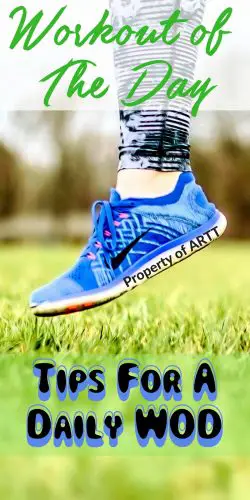
Best Exercises for Each Back Group
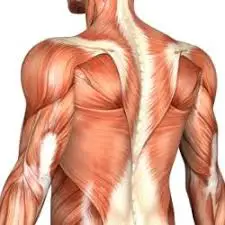 Erector Spinae
Erector Spinae
The best exercises for Erector Spinae muscles are:
• Wall Slides
• Foam roll ( for lower back)
• Single leg deadlift
• Swill ball hip raise
• Frog press
• Reverse crunch
The Shoulder Girdle Muscles
The best exercises that will strengthen these back muscles are
• Dumbbell shrugs
• Barbell shrugs
• Barbell row
• Inclined dumbbell shrug
• Overhead barbell shrug
• Scapular wall slides
• Scapular retraction exercises
• Prone lateral raise.
Rotator Cuff
For rotator cuff muscles, you can do short and simple routines to strengthen them. They include:
• Internal arm rotation
• External arm rotation
• Face pull and
• Scaption.
Teres Major & Latissimus Dorsi
The best exercises which increase muscle performance for these two back muscles are:
• Inverted row
• Seated cable row
• Barbell t-bar row
• Overhead pull down
• Barbell deadlift
• Bend over barbell row.
• Pull-ups.
• Chin Ups
Core Muscle Groups to Concentrate On
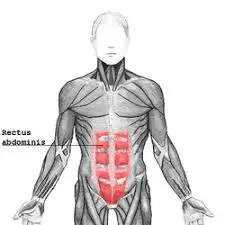 • Rectus Abdominis
• Rectus Abdominis
They are what is known as the abs. Rectus Abdominis is paired muscles which are found on either side of the anterior wall of the abdomen. It is an important postural muscle that assists with breathing.
• Abdominal External Obliques
They are the largest & the outermost of the 3 lateral muscles located on either side of the lateral anterior abdomen. This irregularly shaped group of muscles is broad, thin and occupies the abdomen’s anterior wall.
The structure and location of these muscles in the core is what gives them their different actions. If the abdominal external obliques are all contracted, the abdomen will be compressed i.e. the trunk will be flexed (like what happens when you perform a sit-up).
The function of these obliques is to help to rotate the trunk and the spine.
• Abdominal Internal Obliques
This group of muscles which lie below the abdominal external obliques are found along the abdominal wall just above the abdominal transverse muscles. They start from the from the lumbar fascia and end at the bottom of the rib cage
Abdominal internal obliques help to rotate the trunk, increases pressure in the abdominal area that is essential for the breathing in and out, aids forced respiration and supports the abdominal wall.
• Transverse Abdominis
Transverse Abdominis is the innermost flat abdominal muscles situated beneath the abdominal internal obliques. It contains four muscles which are on the lateral and anterior side of the abdominal wall and it is said to be one of the most significant components of the core.
The Transverse Abdominis provides the body with pelvic and thoracic stability by compressing the viscera and the ribs. In pregnant women, the muscles are of great importance during delivery.
• Multifidus
They are series of muscles that are attached to the spinal column. The Multifidus group of muscles is categorized into two, deep muscles and superficial muscles. The Multifidus help to keep the spinal cord straight and take off pressure from the vertebral discs.
Best Exercises for Each Core Group
Rectus Abdominis
The Muscle building abs exercises for Rectus Abdominis are:
• Squats
• Kneeling cable and machine crunch
• Planks
• Knee Raise
• Ab-wheel roll-out.
Multifidus
The best lumbar Multifidus exercises are:
• Crunches
• sit-ups
• pelvic-rocker exercises
Transverse Abdominis
The best exercises for the Transverse Abdominis are:
• Plank
• Glute bridge
• Russian twists
• Quadrupled lifts
• Abdominal hollowing
Abdominal Internal and External Obliques
Both core groups of muscles can be exercised by incorporating the following sets of Travel WOD:
• Plate Twists
• Seated barbell twists
• Barbell side bends
• Side jack-knife
• Side Plank
• Push-ups
• Bicycle crunches etc.
When You Can’t Get To A Gym, Be Creative With Travel WOD!
Travel WOD: 12 Min EMOM (Every Minute, On the Minute)
You do not need a gym when you plan your travel WOD. A little open floor space in your room, a park, playground, outdoor sports complex. Take a look around your hostel or hotel room—there are probably a bunch of things you can use to add some challenging elements to these movements (put your feet up on the bed or a chair to turn your pushups into decline pushups). Get creative!
You can also take any of the following workout suggestions up-a-notch by adding found weight. For example, if you’re traveling with a backpack, put it on your back or hold it to your chest and do your squats and push-ups with weight. Hold it over your head and add a little extra muscle to your sit-ups. Wear it on your run or up and down the stairs. The Travel WOD is specific to you and your travel. You choose what you put in them.
TRAVEL WOD I
10 rounds: 10 air squats / 10 pushups / 10 sit-ups
TRAVEL WOD II
5 minutes: As many burpees as possible
TRAVEL WOD III
15-minute AMRAP (As Many Rounds As Possible): 5 burpee tuck jumps (add a tuck jump at the end of each burpee) / 10 dips / 15 air squats / 10 hollow rocks
TRAVEL WOD IV
For Time: locate a stairwell and run up for 2 minutes and then back down* / 10 split squats, each leg (using a chair or bench) / 20 v-ups / 30 jumping jacks / 20 v-ups / 10 split squats
* or alternate between mountain climbers, high knees, and tuck jumps for 3 minutes
TRAVEL WOD V
4 rounds: 60 seconds plank-to-pushup / 50 high knees / 20 lunges / 10 hollow rocks
Travel WOD: 12 Min AMRAP (As Many Rounds As Possible)
How to Give Each Group the Proper Workout
In order for each muscle group to receive a proper workout, you can implement workouts from every muscle group as your travel WOD so that all muscles are effectively targeted. Mixing the different workouts with variables such as the training style, experience, lifestyle, goals, and diet will ensure that each group of muscles reaps the maximum benefits.
For the back muscles, a lot of people fail at training this large muscle group because it is part of the body which they don’t often see. The back has two sections, the lower and the upper back. To give the back muscle group a proper workout, you should first train the upper back before moving to the lower back. For the upper back which has muscles like latissimus dorsi and the trapezius, you can do exercises such as pull-ups and pullovers.
To effectively train the core and chest muscle groups, use a different travel WOD during each training session, go easy on your crunches & use a progressive approach. A proper workout will make the muscles in these areas to be toned and strong. Make sure the exercises target all the different parts of the core.
For travelers who are not in the youthful, ripped, athletic zone, there is always yoga and pilates to start you out. Target your flexibility for ease of movement and just walk more. Eventually, you can build up endurance where you are not as tired at the end of the day. Nothing is a bigger buzz-kill to an exciting travel adventure than being in pain at the end of the day.
Using Supplements with the Workout Program
The aim of the entire travel workout program is to build and strengthen the muscles on the different parts of the body. When you are trying to build muscles, your main area of focus is not just training but also the diet. The aim of taking supplements with the workout program is to enhance the functionality of your diet. Supplements are one of the most important components for strengthening and gaining muscle mass. If you have a good workout routine but your diet supplement fails, the results of your workout will be compromised. Supplements produce the difference between good and great results.
You can supplement your travel WOD with:
• Multivitamins –They have components like calcium, magnesium, and biotin that are used for muscle building.
• Creatine supplement enhances muscle strength, increases the lean muscle mass, and helps the muscles to quickly recover during and after exercises.
• Branded Chain Amino Acids (BCAAs) – It’s a supplement that contains leucine amino-acid which is a muscle building powerhouse.
• Glutamine –it contains the human growth hormone that facilitates new muscle growth.It is an anti-catabolic supplement that protects muscles from breaking down.

